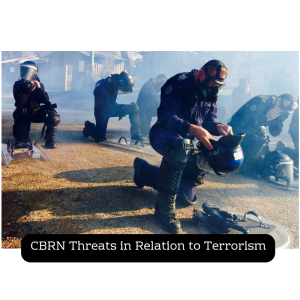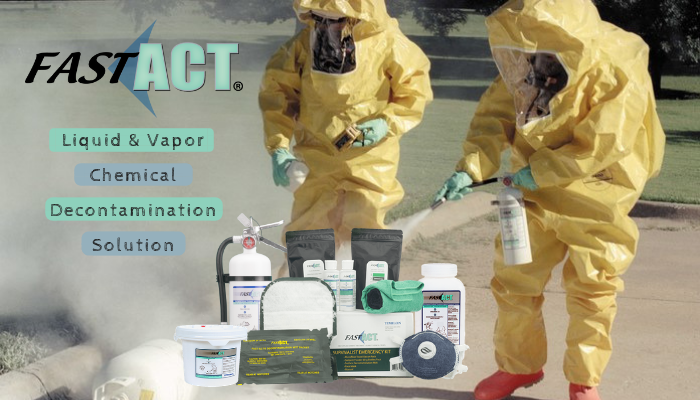 All around the world there is a need for emergency responders, whether in a small or large community or city, to have access to reliable and interoperable CBRNe detectors to protect not only property but also human life. “CBRNe” is the abbreviation that is commonly used to describe the malevolent use of Chemical, Biological, Radiological, Nuclear, & Explosive materials/weapons with the intention to cause mass casualties and destruction. Access to full CBRN protection can be extremely expensive to implement, but with the right CBRN mitigation tools and detection devices, prevention and protection of CBRN threats is achievable.
All around the world there is a need for emergency responders, whether in a small or large community or city, to have access to reliable and interoperable CBRNe detectors to protect not only property but also human life. “CBRNe” is the abbreviation that is commonly used to describe the malevolent use of Chemical, Biological, Radiological, Nuclear, & Explosive materials/weapons with the intention to cause mass casualties and destruction. Access to full CBRN protection can be extremely expensive to implement, but with the right CBRN mitigation tools and detection devices, prevention and protection of CBRN threats is achievable.
Chemical, Biological, Radiological, and Nuclear materials can possess hazardous effects, these effects can include the following in each category:
- Chemical: Poisoning or injury caused by chemical substances. This can include military Chemical Warfare Agents (CWAs), harmful industrial chemicals, and household chemicals.
- Biological: Illnesses that are caused by a deliberate release of a hazardous bacteria, virus, or even a biological toxin.
- Radiological: Illness caused by exposure to harmful radioactive materials.
- Nuclear: Extreme life-threatening health effects that are caused by exposure to harmful radiation, thermal, or blast arising from a nuclear deployment.
Detecting these materials and weapons has been optimized over the last couple of years, with new and improving devices being brought forward for the utilization of emergency responders. These CBRNe detection devices have capabilities that allow for identification and communication of CBRN threats, as well as the capacity to recognize potential CBRNe threats through equipment, education, and effective protocols.
CBRN Attack
CBRN is what can be described as a low probability, high risk threat. Although the chances of an attack utilizing these materials is low, if it were to occur the results could be significant and even deadly. A CBRN attack can occur in several different manners which include:
- Criminal acts, a deliberate dumping or release of hazardous materials to avoid regulatory requirements.
- A maliciously motivated poisoning of one or more individuals.
- Or a terrorist act that involves serious violence or brutality to people or property.
A CBRN attack differs from a normal terrorist attack significantly in many aspects. CBRN agents cause contamination and specific health hazards depending on the type of agent utilized and the amount of the agent deployed into the environment. Conclusively, CBRN attacks can present complete destruction and mass casualties with the sole intent of harming a whole group of people.
CBRN Threat Brief
Terroristic threats are a dangerous potential crisis for large populations of people. The development and utilization of CBRN weapons has proven a lethal threat and one that must be prepared for heavily. The full extent of the potential CBRN threats cannot be predicted as they can evolve in unanticipated ways depending on a number of outside factors. The unpredictability and uncertainty of these threats can pose a challenge in preparing for a possible CBRN threat.
Also, before a CBRN threat occurs, there are no warnings that are initiated prior to the threat, so being alert of potential indicators that may appear is critical. Indicators can occur suddenly and seem out of place such as powders, liquids, or strange smells.
 CBRN Threats in Relation to Terrorism
CBRN Threats in Relation to Terrorism
Terrorism and terrorist threats has been a main focus for the U.S. government. As of the past decades we have seen a growing recognition that vigilance in preventing terrorist groups from obtaining dangerous weapons, such as CBRN threats, is vital to protecting the health and safety of a large group of individuals. The strategy for countering terrorism is strengthened by counter programs that aim to reduce or abolish CBRN materials produced and stored by states.
The use of CBRN materials and the developing expertise of these weapons remains a haunting terrorist threat. Many terrorist groups have stated their intent to acquire, develop, and implement these materials. Within the last couple of years these threats have rung true, as ISIS was found responsible for a hazardous sulfur mustard attack in Syria on August 21, 2015. This attack gave the United States a proactive mission to disrupt and deny ISIS’s CBRN capabilities.
What Does a CBRN Specialist Do?
Chemical, biological, radiological, and nuclear specialists also known as CBRN or chemical operations specialists, are U.S. Army personnel who are responsible for protecting the country from weapons that fall into any of those categories. Specialists that are called to respond to a disaster will distribute protective gear or enter into impacted areas to begin the decontamination process. The CBRN specialist are trained to manage, train, and maintain protective gear that military members will wear when exposed to CBRN threats.
A CBRN specialist protects the country from the threat of these weapons of mass destruction and any weapon of a chemical, biological, radiological, or nuclear type. They plan and use highly advanced equipment in coordination with defense systems that are used against CBRN threats.
Types of Chemical Agent Detection Devices
Chemical agent detection methods will be an essential part of both medical crisis and consequence management. Detection and identification of the chemical agent or agents at the scene of a terrorist incident has to be accomplished but not at the expense of rapid and appropriate medical treatment of chemical casualties. Normally, an incident that involves the release of any chemicals or toxic materials will be categorized as a hazardous materials incident. Therefore, the first emergency responders who arrive on the scene must be capable of determining the Hazmat incident and be able to implement chemical agent detection devices at the scene.
Chemical detection equipment that is currently used by Hazmat teams varies considerably by the location. Large metropolitan areas and their current detectors can range from adequate to no capability for CWA detection. However, Hazmat teams are routinely equipped with a variety of chemical detectors and monitoring kits that can provide useful when chemical threats occur in the environment.
Chemical Decontamination Solution
When a chemical threat is detected in the environment the use of a chemical decontamination solution is needed. Depending on the chemical threat many chemical decon products require a different solution that is needed to apply to the chemical to achieve decontamination – this can be a lengthy process of identifying and decontaminating. However, with the FAST-ACT decontamination products, hazmat and first responders are able to quickly decontaminate a broad spectrum of chemical agents, including CWAs, without having to identify the chemical before deploying the decontamination process. The proprietary technology undergoes a patented process that makes the earth mineral ingredients highly reactive against a broad spectrum of chemicals, adsorbing and neutralizing chemical threats from the surface and air.

CBRNe threats and detection devices are a very helpful and effective measure to have when a threat of this magnitude and danger is present to an environment and a population of people. Being prepared and protected with CBRN detection devices will aid in the overall safety of civilians and emergency responders upon the deployment of these potentially deadly CBRN materials.


